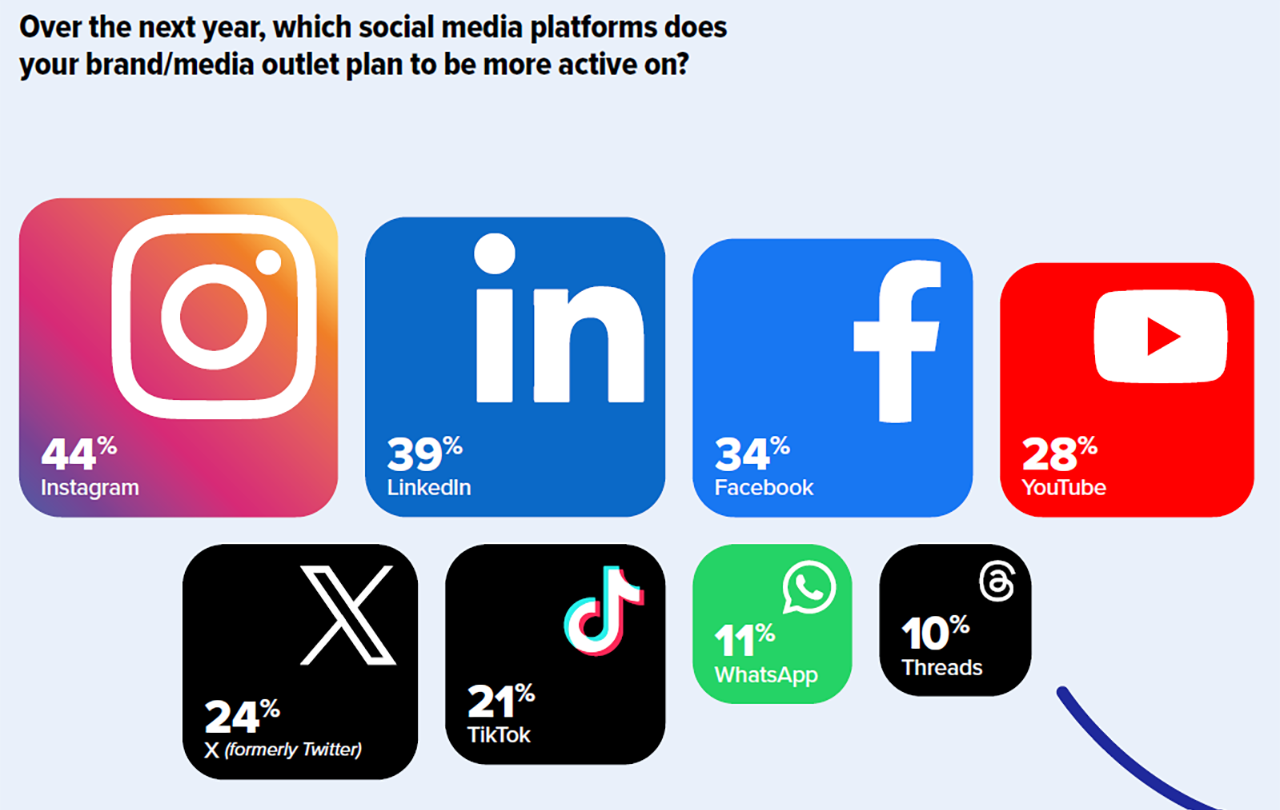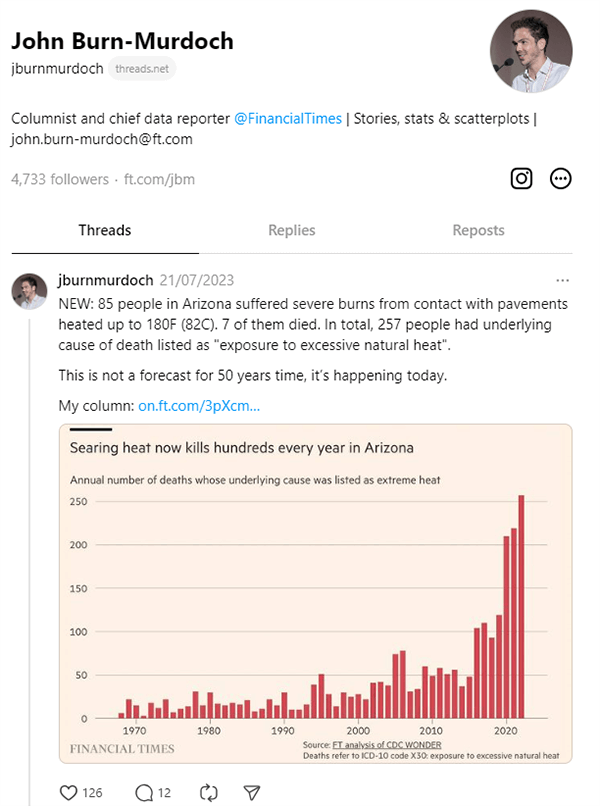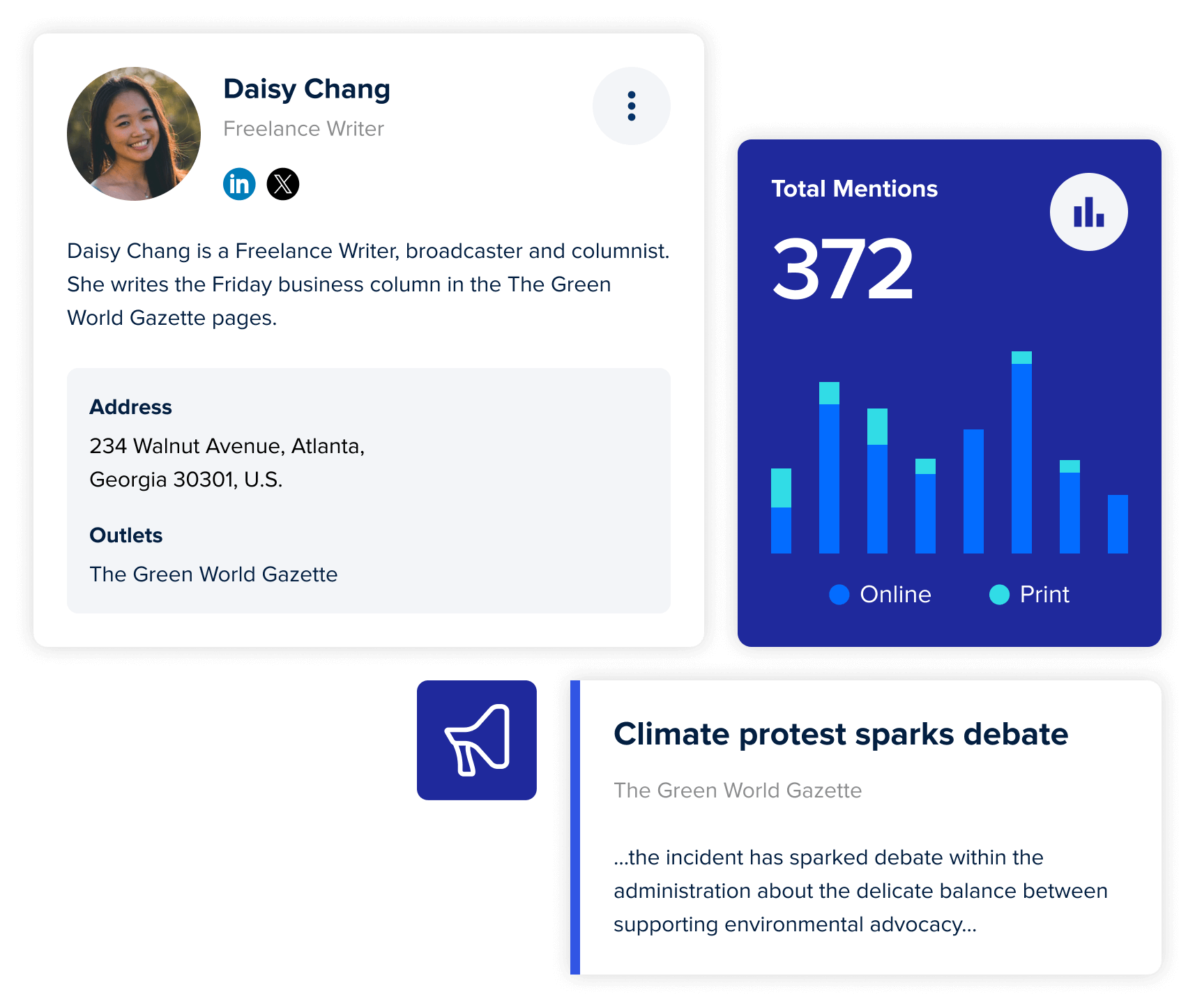At Cision we’ve been tracking journalism’s relationship with social media since 2009 through the State of the Media Report. Back when it started, as a small joint study with George Washington University, we wanted to get a pulse on how journalists were using this innovative new technology called “social media” and interacting with PR professionals.
At that time, only 56% of journalists said social media was “important” or “somewhat important” for reporting and producing stories. Compare that to the 2024 State of the Media, where 97% of journalists say they use social media for their work.
Social media's influence on how audiences consume journalists’ content has been steadily growing. According to 2023 Reuters Institute research, 30% of respondents say that social media is the main way they come across news, up from 23% who said the same in 2018. For the 2023 study, 22% said they access news directly from news websites, down from 32% in 2018.
With news consumption rising across social, it’s understandable that journalists and the brands they work for are pivoting to these platforms. However, their preferences can vary. Cision’s 2024 State of the Media Report, a survey of more than 3,000 journalists worldwide, asked which social media platforms reporters’ outlets plan to be more active on going forward.
Instagram came in first place with 44%, ahead of LinkedIn (39%) and Facebook (34%), indicating a shift from brands toward more visual content.

Of the use cases for social media, most journalists said they use it to publish and promote content. Their top five work-related reasons for utilizing social are:
- To publish/promote content – 71%
- To source information – 67%
- To interact with my audience – 63%
- To network – 55%
- To monitor news, keywords, competitive media etc. – 54%
For PR professionals, it’s important to understand how journalists use social media and what channels they value the most. By helping them source information and presenting story ideas around relevant news stories or topics, PR practitioners can add value and build relationships.
How Has Social Media Changed Journalism?
Think about the way reporters work, how they source and verify information, and publish and disseminate news. That’s all changed from the days of newspapers and broadcast bulletins – largely thanks to social media.
Platforms like Twitter (now X) acted as an extension of the 24-hour rolling news coverage delivered by the likes of CNN, Fox News and MSNBC. Twitter’s earliest incarnation displayed updates in chronological order, offering a real-time feed for users (including journalists) to see breaking news as it happened.
A landmark moment for Twitter came when U.S. Airways Flight 1549 was forced to make an emergency landing in the Hudson River in January 2009. User Janis Krums witnessed it all, and turned to social media to report what he saw.
“There’s a plane in the Hudson. I’m on the ferry going to pick up the people. Crazy.” Krums tweeted along with a Twitpic photo to his 170 followers (he now has more than 10,000). Within the hour Krums was being interviewed by major U.S. broadcasters as the man who broke “The Miracle on the Hudson” story.
Twitter co-founder Jack Dorsey once said that this photo “changed everything” for the social media company. “Suddenly the world turned its attention because we were the source of news – and it wasn’t us, it was this person in the boat using the service, which is even more amazing,” he told CNBC.

The tweet demonstrated social media’s potential to break and shape stories. The news was no longer driving social media, social media was driving the news.
Social’s trending features soon became ubiquitous, showing the most popular and talked-about topics at any given moment. For journalists and news organizations, this provided a real-time snapshot of what's happening worldwide (and what they should consider covering).
Reporters turned to social media to find and research stories, then promote them across these platforms and reach a wider audience. They could also use it to connect directly with their audience and communicate with sources. Public figures became more accessible, and anything they published on their own social feeds became material for news outlets.
Social media’s rise also affected how journalists work day to day. Newsrooms have gradually shifted from boots-on-the-ground reporting to more desk-based research and working with contacts remotely. This, in truth, began with the internet and email but was amplified by the emergence of social media.
The more digital outlets and social platforms emerged, the faster stories circulated and the more accessible they became to a global audience. As people increasingly get their news from a diverse range of social media feeds, what does that mean for the value of an exclusive?
During a Cision webinar, Alison Phillips, former editor of The Mirror, said that social media has steered many media brands toward a “digital first” mindset. “Something only remains exclusive for a couple of minutes... if you [publish something in] print somebody else can get it out digitally in seconds,” she said. “You need to make sure that if it’s going anywhere digitally, it’s going on your own platform first.”
Platform ownership rings true for freelance journalists, too. Social has created ecosystems that offer outlets for independent journalists to build their own personal brands. With the ability to publish directly to audiences through X, Substack, Medium, and more, freelance journalists can cultivate a following and monetize their content without being beholden to traditional media outlets.
Social has created a more fragmented and diverse media landscape – and for journalists and PR and comms teams, that means navigating more information (and challenges) than ever before.
Social Media and Journalism: What Are the Challenges?
Social media has created new opportunities for brands and reporters to get their stories seen. However, it also presents fresh challenges, both to traditional media organizations and journalists.
The 2024 State of the Media Report saw 28% of journalists describe “competing with social media influencers and digital content creators for audience attention” as one of their biggest challenges in the last year. It’s not just influencers that have disrupted the journalism/social media relationship, there are many other factors in play, such as...
Business Model Disruption
As journalism and social media become increasingly intertwined, the traditional business model of subscriptions and advertising revenue has found itself severely tested. As news moves freely across platforms like X, TikTok and Facebook, it’s now much harder for news organizations to monetize their content.
Additionally, digital advertising has made it tough for publishers to generate sufficient revenue to sustain their operations. Print advertising has declined significantly as readers migrate online, while much of digital ad revenue is captured by tech giants like Google and Facebook, leaving news organizations competing for a smaller slice of the pie.
Exposure to Personal Attacks
Social media has opened journalists to increased personal attacks and harassment, with online trolls and critics often targeting them for their reporting, opinions or perceived biases.
This blurring of the lines between personal and professional can take an emotional toll and potentially lead to self-censorship, or even leaving social media altogether.
Fake News and AI-Generated Content
Misinformation and fake news on social media has posed a major challenge for journalists, who now find themselves operating in an environment where false information can spread quickly. This chimes with the 2024 State of the Media Report, where 33% of journalists said they found online misinformation one of their biggest challenges in the last year.
Plus, generative AI tools like ChatGPT are raising concerns about creating manipulated media at scale that undermine the credibility of journalism. You need only look at the weaponization of deepfakes, demonstrated last May when a fake image of the Pentagon on fire spready quickly on X and caused the stock market to briefly dip.
Verification and Fact-Checking Challenges
Social media fact-checking is a time-consuming and resource-intensive task, putting additional strain on newsrooms already stretched thin.
With the vast amount of information circulating on social media, journalists face an uphill task to verify the authenticity and accuracy of sources, images, and videos. This has become even more challenging on platforms like X, where a monetized system means any account, genuine or not, must pay for verification.
Speed vs. Accuracy
The constant demand for real-time news updates and the pressure to be first to break a story on social media can sometimes conflict with the journalistic principles of accuracy and thoroughness.
Journalists must find a balance between delivering timely information and ensuring that their reporting is well researched and fact checked.
Algorithms and Echo Chambers
Social media also comes with challenges around platforms’ use of algorithms to prioritize content that draws engagement – potentially at the expense of nuanced, fact-based reporting.
This has led to the spread of misinformation and the creation of ideological echo chambers, where people primarily encounter news and viewpoints that only align with their existing interests.
How Journalists Use Social Media
As journalists increase their social activity, it’s vital for PR professionals to understand how they use the various platforms. For example, their Instagram feeds will likely look a lot different to their LinkedIn profile. Or they may be very active on X, but have little presence on Facebook. Oftentimes, they might favor one platform for breaking news stories, but use another to build their personal brands and interact with their followers.
The differences in the way journalists use social media should inform how PR professionals use social media in their outreach. For example, while you may approach a journalist who’s active on Instagram with a story that can be told visually (and providing images, video, or infographics), you might use LinkedIn as an opportunity to build a rapport with them, following them and commenting on their posts.
We’ve highlighted some of the common use cases among journalists for today’s most popular social media platforms. Keep this in mind when creating your social media PR strategy.
How Journalists Use Instagram
Instagram provides journalists with a visual platform to share imagery, engage with readers, and promote their stories. Here they can build a more personal connection with their audiences and expand their reach beyond traditional media channels.
Other uses for Instagram for PR pros to consider:
- Behind-the-scenes glimpses: Journalists can showcase imagery from events, conferences, or their workplace, giving followers the chance to see how they work daily.
- Personal brand building: Instagram lets journalists showcase their interests and expertise beyond work; it helps them establish a unique voice and connect with a like-minded audience.
- Visual storytelling: Striking images and video can complement written work, offering a visual route into a journalist’s stories.

How Journalists Use LinkedIn
A career-focused platform, LinkedIn is becoming increasingly valuable for journalism – as demonstrated by the 2024 State of the Media revealing that 39% of media brands are expected to increase their usage this year.
On an individual level, LinkedIn helps journalists with...
- Professional networking: Journalists can connect with other professionals in the media industry – think sources, editors, and potential collaborators, facilitating networking opportunities and potential career moves.
- Sharing thought leadership content: Posting updates, articles, or commentary on relevant industry news or trends, journalists can position themselves as knowledgeable voices within their areas of coverage and expertise.
- Showcasing personal accomplishments: LinkedIn is an environment for journalists to talk about their own work, their professional achievement and the evolution of their careers. It’s a place to enhance their credibility and visibility.
How Journalists Use X/Twitter
Long seen as a destination for breaking news, X/Twitter has evolved from a fast-paced platform for sharing concise updates to an algorithm-driven resource that captures what’s trending at a given moment.
Though it’s changed significantly in recent years (with many features now for paid subscribers only), it’s still a popular and valuable resource for journalists to...
- Share real-time news and commentary: The platform’s real-time nature still makes it a go-to for journalists to report on breaking news events as they unfold, sharing live updates, images, and videos with their followers.
- Take part in Spaces: As more journalists explore podcasting and audio, X’s Spaces offers a way for reporters and brands to hold live conversations and connect with their audience in a new way.
- Source information and network: Journalists can use X to crowdsource information, monitor trending topics, and connect with experts to provide valuable insights for their reporting. PRs should look out for #journorequest or #journorequests for ways to connect.

How Journalists Use Facebook
Though predominantly seen as a personal social media platform, Facebook can still be a valuable tool thanks to its large user base and multimedia capabilities and functions.
Journalists may use Facebook to...
- Promote and distribute content: Journalists can make their Facebook profiles public to share links to their articles or broadcast segments, increasing visibility and driving traffic to their primary platforms.
- Leverage multimedia: Facebook’s strength with multimedia formats means journalists can experiment with everything from live broadcasts to Stories and 360-degree videos, enhancing their work and creating a more immersive experience for their followers.
- Join industry groups and discussions: Facebook discussion groups relevant to a journalist’s area of coverage are useful for sourcing and gathering information, engaging with relevant communities and sharing content. For example, The Social Media Geekout is worthwhile for any journalist (or PR for that matter) looking to stay informed on all things social.
How Journalists Use TikTok
With 36% of TikTok users between the ages of 18 and 24, the video platform is a useful tool for reaching younger audiences. Startup brands like The News Movement and established organizations like the BBC are building sizable followings through their short-form TikTok content. Mosheh Oinounou, founder of Mo News, told Cision that “Gen Z and the Alpha Generation are now using TikTok in lieu of Google to search for information.”
On an individual level, TikTok can also help journalists...
- Experiment with new storytelling formats: TikTok encourages journalists to explore creative and visually compelling ways to package news stories, from using humor and memes to leveraging popular trends and challenges.
- Repurpose existing content: TikTok offers scope for journalists to repackage existing content in video form, bringing it to a new audience.
- Build personal brands: Like Instagram, TikTok gives journalists the chance to show their personal interests, and share behind-the-scenes experiences. This fosters a more personal connection with their followers over time.
How Journalists Use Threads
Launched in July 2023, Threads works similarly to X with users posting short updates of text, links, images, and videos. As a Meta-owned platform it’s integrated with Instagram, meaning journalists can bring over their Instagram followers to Threads.
Though in its infancy, Threads can help journalists...
- Showcase their latest content: With its multimedia capabilities journalists can post their latest images or video work, plus share links to their stories on other media outlet websites.
- Publish longer-form ‘Threads’: Like X, Threads lets users link together multiple posts – worthwhile for any journalist wanting to break down a longer story or share sequential updates from an event.
- Interact and connect: Threads’s ability to reshare and comment on other users’ posts makes it a useful platform to interact with followers, gauge reader feedback, and network and connect with experts for potential stories.

How Journalists Use Reddit
Reddit is a valuable resource for journalists seeking diverse perspectives, niche expertise, and grassroots insights. By engaging with subreddit channels, journalists can tap into user-generated content, crowdsource information, and link with sources from various backgrounds and interests.
Reddit can also help journalists with...
- Information gathering: Journalists can monitor relevant subreddits to look for potential story angles, find eyewitness accounts, or seek expertise from knowledgeable users on specific topics.
- Supplementing research: Reddit's archive of discussions and user-submitted content is vast and across almost any niche you can think of. This can aid journalists in background research or exploring alternative viewpoints on stories they're covering.
- Take part in an Ask Me Anything (AMA): These sessions allow users to pose questions to public figures or those with specialist knowledge and experience. Journalists can participate with their own questions or, if they have a large enough profile in their specific industry, host one themselves to build their profile.
Social Media Tips for PRs Working with Journalists
The social media landscape is sizable and PR professionals looking to connect with journalists across multiple platforms will naturally face challenges.
Here are six quick tips about how best to work with reporters across social...
- Follow and engage with relevant journalists: Your brand and personal social accounts should be following reporters aligned with your sector and industry. That way you can both stay on each other's radar and be aware of the latest work they’re producing.
- Share newsworthy and valuable content: This will give you a solid social media presence and establish credibility with reporters. This is especially useful for new organizations or those that haven’t gotten much publicity yet.
- Analyze journalists’ social activity and preferences: How are the journalists you follow using social media? Is it to promote content, share personal posts, or engage with followers? Ensure you’re aware of how individual journalists utilize social before reaching out to them directly.
- Be wary of pitching via social DMs: Sliding into a journalist’s DMs might not be the most effective way to reach them. According to the 2024 State of the Media Report, just 2% of journalists say they prefer to be pitched via social or direct message. Nineteen percent say they would put a PR on their “don’t call” list if they reached out unsolicited on social.
- Understand journalists’ challenges with social media: Social media is both a platform to help PR pros understand what makes journalists tick on a personal and professional level, and an avenue for getting to know the kind of content their followers want. By understanding their pain points, you can provide them with the resources they need and become better partners.
- Take a cue from journalists: Reporters are now considered influencers and experts at building their own brands. PR professionals would do well to use social media in a similar way. Not only is it also a great way to build awareness for clients and understand what's trending, but a strong social media presence/following will help build your credibility in the eyes of journalists.
PR software can also help you bring together the points above. For example, a platform like CisionOne offers social and outreach features to help you track conversations across multiple social platforms and build out robust media lists for pitching.

Social Media’s Impact on Journalist and PR Relations
Journalists looking to harness social media need to be nimble and creative. While platforms like LinkedIn and X are text-driven, Instagram and TikTok rely on visuals, putting the onus on journalists to develop their multimedia skillsets.
For PR teams, understanding this shifting landscape and its impact on journalism is crucial. As reporters adapt to new platforms and formats, PR pros must tailor their strategies accordingly to leverage social media and engage with journalists to share compelling stories.
As well as adapting their strategies to meet the changing needs and preferences of journalists and their audiences, it’s worth remembering that PR practitioners face many of the same challenges as editorial teams.
Ultimately, both are looking to craft compelling stories that resonate with their respective audiences – and many of the lessons they take from journalism’s use of social media can be applied to content for their own brands and campaigns.
By developing a robust knowledge of social media, PR professionals can position themselves as key partners for journalists and gain a greater understanding of how it impacts them, too.
For additional insight on social media and PR, check out these resources:
- The Art of Social PR: The Complete Guide to Social Listening for PR
- Understanding Social Media Monitoring
- Social Listening 101: What It Is and Why It Matters
Ready to learn more? Find out how CisionOne Social can help connect you with the right journalists and influencers to share your stories.








